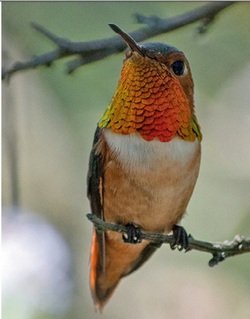
Cool Facts
- In the first half of the 20th century, the Anna's Hummingbird bred only in northern Baja California and southern California. The planting of exotic flowering trees provided nectar and nesting sites, and allowed the hummingbird to greatly expand its breeding range.
- The dive display of the Anna's Hummingbird lasts about 12 seconds, and the male may fly to a height of 40 m (131 feet) during the display. He starts by hovering two to four meters (6-13 feet) in front of the display object (hummingbird or person), and then climbs in a wavering fashion straight up. He plummets in a near-vertical dive from the top of the climb and ends with an explosive squeak within half a meter of the display object. He then makes a circular arc back to the point where he began. On sunny days the dives are oriented so that the sun is reflected from the iridescent throat and crown directly at the object of the dive.
- On rare occasions, bees and wasps may become impaled on the bill of an Anna's Hummingbird, causing the bird to starve to death.
- Hummingbirds are strictly a New World animal. They fascinated the first Europeans who arrived on the continent. Christopher Columbus wrote about them and many wondered if they were a cross between a bird and an insect (at one point being called “flybirds”). Later, their feathers became fashionable ornaments in Europe (a practice that has thankfully fallen out of favor).
- What do you call a flock of hummingbirds? Few animals have so many applicable terms, and none so beautiful. Instead of calling them a flock, choose between a bouquet, a glittering, a hover, a shimmer, or a tune of hummingbirds.
- Native Americans held hummingbirds in high esteem. Many of their legends describe them as busily bring the rain to quench eruptions or poking holes in the night sky that became the stars. The Navajo say that the characteristic mating dive is a way for them to check what is above the blue of the sky.
- The iridescent throat patch of male hummingbirds is called a gorget. The Anna’s gorget extends over its head, making it more of a balaclava than a bib. Oddly, female Anna’s have a tiny red gorget—females of most species have none.
- Anna's Hummingbirds normally have a body temperature of around 107 degrees Fahrenheit—that's a scorching temperature for a human. When outside temperatures fall, Anna's and many other species of hummingbirds enter torpor. Their breathing and heart rate slow, and their body temperature can fall as low as 48 degrees Fahrenheit. When the temperature warms, the hummingbirds can become active again in a few minutes.
- Hummingbirds have tiny legs and can neither hop nor walk, though they can sort of scoot sideways while perched.

 RSS Feed
RSS Feed
